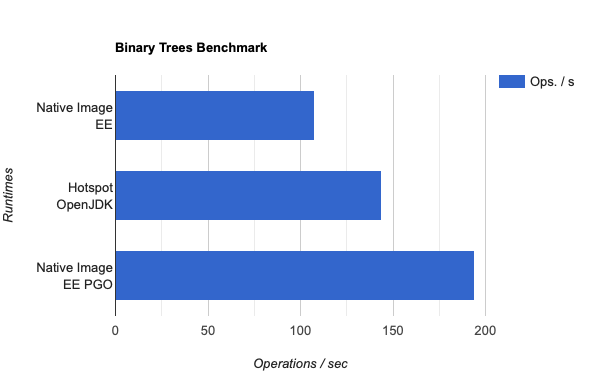This demo shows how to run a Java Microbenchmark Harness (JMH) benchmark as a native executable.
To build a native executable version of this benchmark you need to run the Tracing Agent to supply the reflection configuration to the native-image builder. This has already been done for you to save time and the generated
configuration can be found in src/main/resources/META-INF/native-image/.
Note: To generate the configuration yourself, ensure that the JMH
forkparameter is set to0, which can be performed from the command line using the option-f 0. It can also be achieved within the code by using the@Forkannotation.
In order to make a JMH benchmark run as native executable, built by GraalVM Native Image, you can not fork the benchmark process in the same way as JMH does when running on the JVM. When running on the JVM JMH will fork a new JVM for each benchmark in order to ensure there is no interference in the measurements for each benchmark. This forking process is not possible on GraalVM Native Image and you should consider the following guidance when building JMH benchmarks that are meant to be run as native executables:
- You should only include a single benchmark in each native executable
- You need to annotate the benchmark with,
@Fork(0)to ensure that the benchmark is not forked - If you want to profile the benchmark in order to generate an optimised benchmark, you should, obviously, ignore the benchmark results whilst profiling
-
Download and install the latest GraalVM JDK with Native Image using the GraalVM JDK Downloader.
bash <(curl -sL https://get.graalvm.org/jdk) -
Download or clone the repository and navigate into the
jmh/benchmark-binary-treedirectory:git clone https://github.com/graalvm/graalvm-demos
cd graalvm-demos/jmh/benchmark-binary-tree
To build and then run the benchmark as a Java application, run the following commands:
./mvnw clean package exec:execNote that within the pom.xml file there are instructions to explicitly turn off GraalVM JIT compiler using the option -XX:-UseJVMCICompiler.
This means that benchmark will run using the C2 JIT compiler.
The application will run the benchmark and display the results to the terminal. The final result is the most significant. You should see something like:
Benchmark (binaryTreesN) Mode Cnt Score Error Units
BinaryTrees.bench 14 thrpt 6 143.628 ± 9.007 ops/sNow build a native executable using Native Image. This demo uses GraalVM Enterprise Native Image, however, if you are using GraalVM Community, you will probably see lower figures for throughput.
-
Build a native executable, run the following command:
./mvnw package -Pnative
-
Run the benchmark as a native executable:
./target/benchmark-binary-tree
These are the results obtained with GraalVM Enterprise Native Image 22.3.0:
Benchmark (binaryTreesN) Mode Cnt Score Error Units BinaryTrees.bench 14 thrpt 6 107.388 ± 2.038 ops/s
Note: This requires Enterprise Edition.
If you are using GraalVM Enterprise Native Image you can improve the performance of this benchmark by taking advantage of a feature named Profile Guided Optimisations (PGO).
First, you will need to build an instrumented version of the native binary that contains extra code to trace the execution of the program and to to profile it. Therefore, it will run slower than the previous version. When the execution has finished, it will generate a profile file, default.iprof, in the root directory. This file, containing profiling information about the application, will be used to build a more efficient native executable.
-
To build the instrumented version of the native executable, run the following command:
./mvnw package -Pinstrumented
-
Then run it to generate the profile file:
./target/benchmark-binary-tree-instr
-
Now that you have generated the profile file, build and run the optimised version of the native executable:
./mvnw package -Poptimised
./target/benchmark-binary-tree-opt
These are the results obtained with GraalVM Enterprise Native Image 22.3.0:
Benchmark (binaryTreesN) Mode Cnt Score Error Units BinaryTrees.bench 14 thrpt 6 194.215 ± 2.746 ops/s
The results you see will vary depending on the hardware you are running on. The results above are from a 2019 MacBook Pro, i7, 32 GB RAM running GraalVM Enterprise 22.3.0 for JDK 17.
See the previous data collated into a chart:
